WELCOME TO WHEELIE-VILLE
The front straight at the Losail International Circuit is 3500 feet long, and on our out lap, former MotoGP rider and current KTM brand ambassador Jeremy McWilliams wheelied roughly ¾ of it. By midday I lost count of how many wheelies I’d watch others do, or do myself. That is life with the KTM 1290 Super Duke R. And it’s amazing.
Already one of the best bikes in the naked bike category, I’d argue that the Super Duke R didn’t need to be updated. It’s always made plenty of power (an understatement), felt comfortable ergo-wise, and been an overall good balance between capable commuter/ absolute track weapon. Ever evolving emissions regulations required at least some attention though. So too did an electronics package that was not entirely up to par with the competition.
Which brings us to back to the 2017 1290 Super Duke R KTM is letting me ride (wheelie) around the Losail International Circuit. Updated with a more powerful engine, refined suspension package, reworked ergos, and more capable electronic rider-aid suite, it’s the result of KTM’s relentless testing and R&D, if not the brand’s obvious fear of becoming comfortable with “good enough.”
THE UPDATES
I said earlier that the Duke’s engine is more powerful (peak power is up 4 hp), but truth is KTM wasn’t much worried about power. This year, priority was with building a more flexible and smoother running engine. It’s stiffened the crankshaft and outfitted the bike with 690 Duke-culled resonator chambers on the cylinder heads as a result. Those chambers help disturb the flow of gases into the combustion chamber through a whirl effect, thus creating a better air/fuel mixture for improved combustion. KTM says this helps with overall smoothness and fuel efficiency. Meanwhile, the updated crank improves reliability and reduces vibrations.
Other engine updates include titanium intake valves with new face design for higher compression ratio, plus 10mm shorter inlet funnels that have allowed for KTM to raise the rev ceiling by 500 rpm. The end result is not only a broader power band, but also a claimed 177 peak hp and 104 pound-feet of torque—the most powerful LC8 engine KTM has ever wedged into a production bike. “It’s no E-bike, but with the changes it’s not as thirsty as before, too” says Henrik Wiese, the head of KTM’s LC8 engine platform.
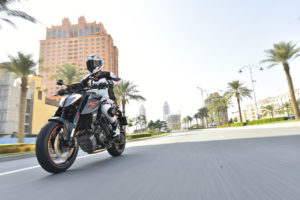
The Pearl-Qatar has strict, non Super Duke R-friendly speed limits. Truth is though, the Duke is plenty okay with cruising around town at a responsible pace. Fueling is faultless, ergos are comfy, and the engine is smooth below 4,000-5,000 rpm.
Cornering ABS remains, but now sits alongside a lean-angle-sensitive traction control system and (optional) Motor Slip Regulation system, the latter of which is described by KTM as a corner-entry traction control system (you’ll actually see the TC light flash on corner entry, as the system is activated).
Riding modes include Sport, Street, and Rain, though you can now upgrade to an optional Track mode, which adds 1) launch control, 2) anti-wheelie off setting, 3) throttle response selection, and 4) MTC spin adjuster, which enables you to adjust allowable wheel spin from levels 1 to 9. If you’re heading to the track or plan on ever riding the Super Duke R as it was intended to be ridden, it’s definitely something you’ll want.
Cruise control is standard, but you’ll have to upgrade to KTM’s Performance Pack if you want to add the up/down capable Quickshifter+ system, KTM MY RIDE (which connects your phone to the bikes new TFT display through Bluetooth), and previously mentioned MSR system. This kit is perhaps less of a necessity since, A) riding means disconnecting from your phone/ life stresses and B) the Quickshifter + system does not provide the most seamless of downshifts, especially when done in rapid succession. Throw in heated grips and I may have re-thought that last sentence…
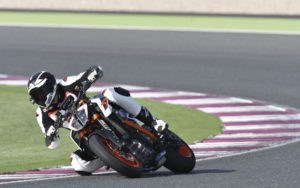
We had the option to ride a 1290 Super Duke R with parts borrowed from KTM’s PowerParts catalog and walked away impressed. We now understand why guys are going out and racing Super Duke Rs. Stay tuned for the full story and parts list.
Suspension is updated for 2017, KTM having outfitted the 48mm WP Suspension fork with stiffer springs and re-valved the rear shock. Meanwhile, the handlebar is 20mm wider, 5mm lower, and positioned 18.5mm further forward. It’s still a naked bike, meaning big speeds equate to bigger neck aches, but KTM hopes this new bar will keep you hunkered down and somewhat out of the wind. It also solves a problem I had with the old bike, which was the ultra-short bar forcing me to rest my hands on its ends in canyon riding.
Further down you’ll find Brembo M-50 monobloc brake calipers as well as Metzler’s surprisingly sticky Sportec M7 RR tires, rather than Dunlop rubber.
I’ve yet to mention anything about the styling because, well, I think the new bike’s styling speaks for itself. The Super Duke R has always been an aggressive looking motorcycle, and for 2017 KTM has made it look meaner yet by stripping some of the panels off (notice the plastic-free tail section) plus redesigning the headlight casing. “We want it to look scary,” says Thomas Kuttruf, Head of Press and PR.
It does.
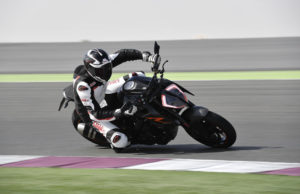
Even in stock trim, the Super Duke R works its way around a racetrack without breaking much of a sweat.
THE RIDE
The Super Duke R isn’t a mean motorcycle though. At least not with the electronics turned on and you riding it like a responsible human being. The engine feels smoother below 5,000 rpm and, despite the bar position looking more aggressive on paper, the bike is still plenty comfortable around town. I don’t think you’d notice the change in ergos unless you did a back-to-back comparison between ’16 and ’17 models.
The new TFT display is easy to read at a glance and easily navigated via the four-button switch on the left side of the handlebar. I’ve had reservations about this setup in the past, but it’s grown on me over the past couple of months. I now never spend more than 30 seconds scrolling through the screen and selecting desired rider-aid settings. Perhaps I owe an apology to the guys at KTM who designed the system. You were right all along…
Speaking of electronics, throttle response feels sharper in the new, more aggressive Track mode, which is why I opted for the less-aggressive Sport setting for most of my street riding and early track sessions. That is, of course, until I forgot to update the throttle response selection for one session and learned to love the Track setting. Which is to say, like the dash setup, you’ll get used to it.
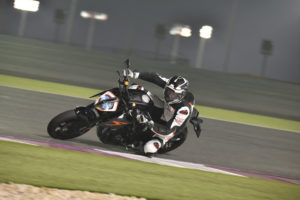
Under the lights at the Losail International Circuit.
In Track mode, I also experimented with MTC levels 7 to 1 and noticed that the system’s cut felt shorter than before. Part of what makes a modern traction control system “good” is its ability to recognize slip early, run through the list of possible reactions in the shortest amount of time possible, and then make the necessary cuts as quickly as possible. This system does that, while at the same time allowing for more slip than previous-generation KTM systems. This is the thing I was most focused on going into the test, as the Duke’s traction control functionality has always been, in my opinion, the bike’s biggest weak point. To see KTM make such strong progress on this front is exciting.
As for the other electronic systems, I appreciated having wheelie control separate in Track mode, but found the system to be rather inconsistent (a likely result of how it reacts dependent on lean angle) and preferred it off. Meanwhile MSR, which opens the throttle butterflies on decel to prevent the rear tire from locking up on road debris, etc., (but is not considered engine braking) gave me a good feeling on corner entry. My only disappointment there is that, because the system pulls information from the ABS, it is automatically turned off whenever you turn ABS off or switch over to Supermoto mode. Which is unfortunate because I really, really like Supermoto mode…
The updated WP Suspension feels street soft but also more controlled through its travel, with overall better bump absorption and good feel as you crack the throttle open on corner exit. Like the rest of the bike, it feels refined.
You could probably tinker with suspension settings to get rid of that front/rear softness if and when you head to the track (you are taking it there, right?), but as a whole the updated WP bits are an improvement over the already capable pieces on the previous-generation Duke. Again, refinement.
Brakes are as powerful as you need them to be thanks to the M-50s that we say should just come on eery bike. Period. There’s a little fade early on in a track session, but the lever stops coming in at some point and the system provides good, consistent stopping power from that point on.
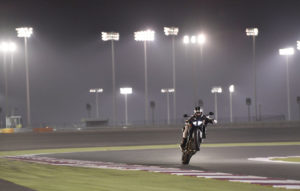
The 1290 Super Duke R wheelies so easily it almost feels like you’re cheating. We’re okay with that.
You’ll equally appreciate the engine’s 500-rpm-higher rev ceiling, which enables you to hold onto a gear between corners and not test the rev limiter in those transitions where you’re so close to not having to upshift, then downshift again. This makes quick laps at the track a less busy affair. And while I imagine the benefits will be less noticeable in day-to-day street riding, I think it’s impressive for KTM to have added flexibility to a powerplant that was already known for its flexibility.
In a way, that kind of sums up the 2017 1290 Super Duke R package as a whole though. This bike was already exceptionally good, and now it’s just a small amount better. It feels more refined. More mature. And a step above its predecessor in all the areas it needed to be.
More impressive, to me, is that KTM has managed to do all this while facing the same Euro 4 emissions regulations that are challenging other manufacturers. It’s built a bike that’s more powerful, but also one that runs smoother and is more efficient. And it’s done all this without removing any of the charm that made the original so great, or without tacking ungodly amounts of weight onto the overall package.
It’s built a truly fantastic machine, plain and simple. One that I challenge you to not want to ride while up on one wheel. Everywhere. While laughing hysterically inside your helmet. Because wheelies.
| SPECIFICATIONS | |
|---|---|
| ENGINE TYPE | Liquid-cooled V-twin |
| DISPLACEMENT | 1301cc |
| BORE & STROKE | 108.0 x 71.0mm |
| SEAT HEIGHT | 32.9 in. |
| RAKE | 24.9° |
| TRAIL | 4.2 in. |
| WHEELBASE | 58.4 in. |
| FUEL CAPACITY | 4.8 gal. |
| CLAIMED DRY WEIGHT | 430 lbs. |
| PRICE | $17,999 |

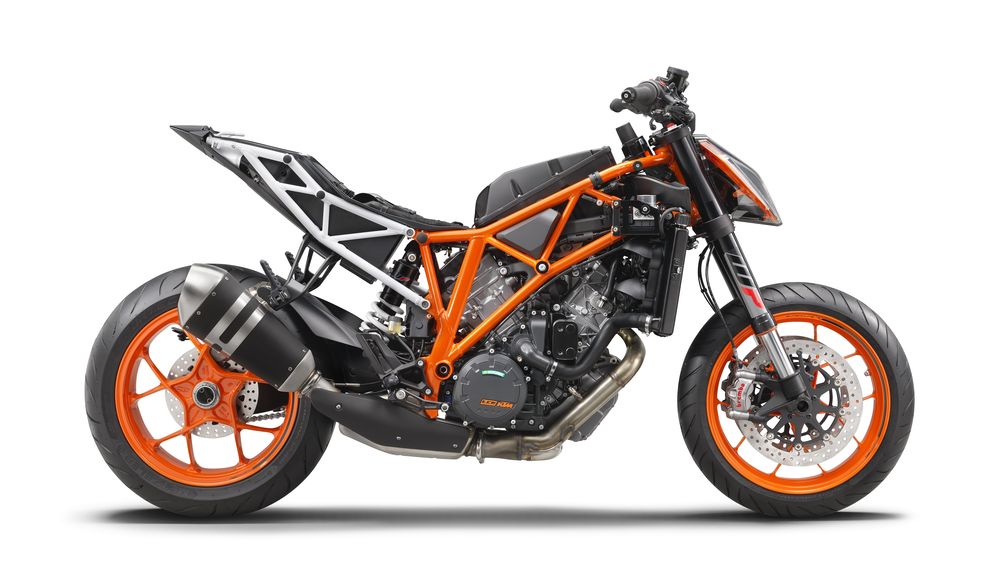

Leave A Comment